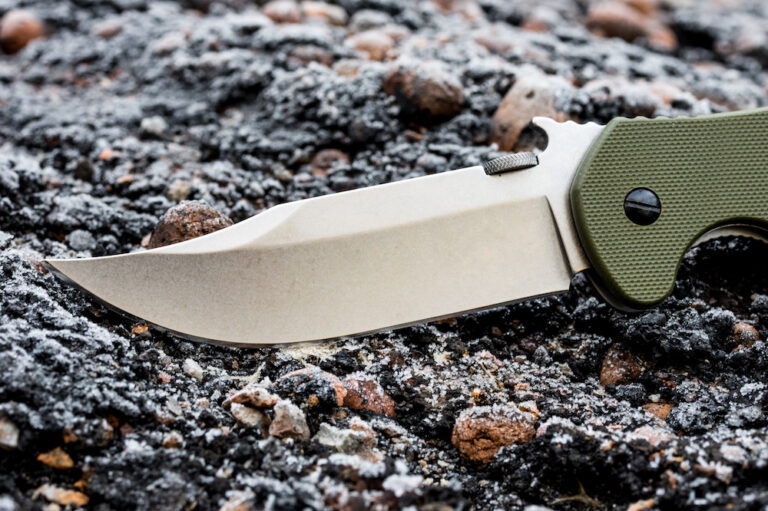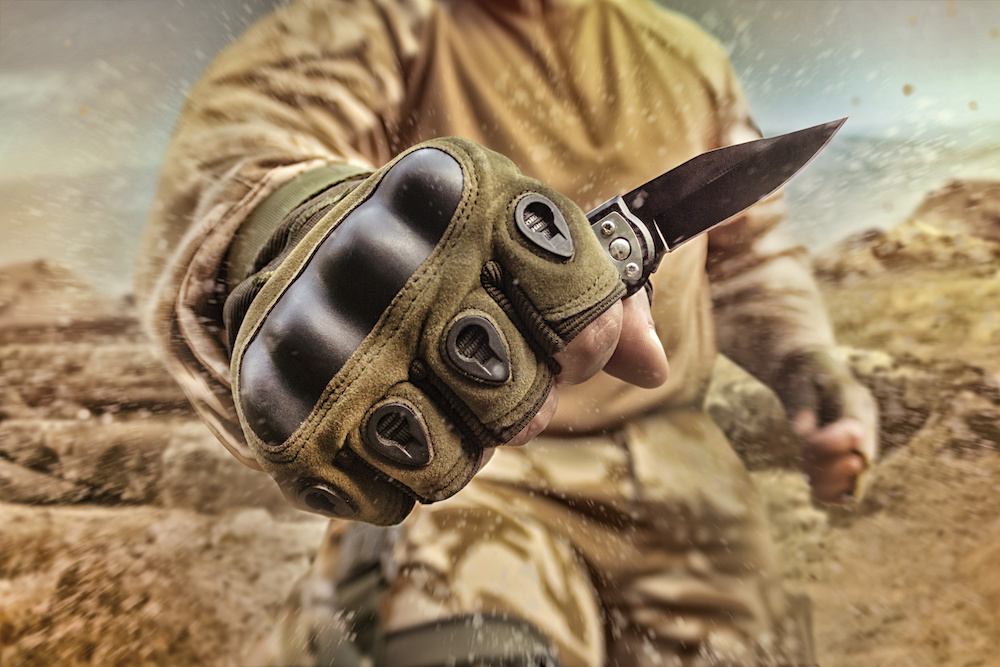Signup for our monthly newsletter and get your FREE "Tactical Gear" Guide
How To Use A Tactical Knife and Make the Most Out of Your Gear
- Home
- Tactical Knife Advice
- How To Use A Tactical Knife

This site contains affiliate links to products. We may receive a commission for purchases made through these links.
After much consideration, you now have a tactical knife.
You’ve browsed through the tactical knife buying guide, checked out the star rating, and determined the best price range.
After going through customer questions and reading through answered questions online, you’ve chosen a knife for yourself.
It’s brand new and gorgeous in your hand, but what’s next? Simply owning one is not enough.
You have to learn how to use a tactical knife to its fullest potential.
What’s the best way to utilize such a multi-purpose item while maintaining its structural integrity?
More importantly, how can you keep yourself safe while wielding it?
Table of Contents
What Is A Tactical Knife?
For starters, any knife can be used in self-defense.
That said, tactical knives are affordable knives specifically designed for combat and emergency use.
This type of knife is like a jack-of-all-trades in that it is versatile and a good option for someone with a crisscross of hobbies and interests.
If you want a more personalized type of knife, there are a wide array of knives to choose from:
- Everyday Carry (EDC) knives
- Survival knives
- Duty knives
- Hunting knives
- Utility knives
- Buck knives
- Butterfly knife
- Bowie knife
Folding vs. Fixed-Blade
The type of knife you end up choosing will determine how you will use that tactical knife.
There are two common types of tactical knives: folding tactical knives and fixed blade tactical knives.
Foldable knives are more convenient when their primary function is concealment. They take up less storage and carrying space.
However, the mechanism used to fold the knife and have it spring open means that it is heavier compared to its counterpart.
Foldable knives also have their own locking mechanism, which is an added level of safety for users.
A good example of this is the GVDV Pocket Folding Knife and the Modern Damascus Steel Folding Pocket Knife.
A fixed-blade knife is easier to handle for beginners. They are good for heavy-duty use or emergency situations.
With a fixed-blade knife, you will find that it’s comparatively easier to manage because what you see is what you get.
Moreover, you won’t have to worry about maintaining the functionality of an added spring mechanism the way you would foldable knives.
Handle Types
Much thought goes into the design of a tactical knife, from the handle design and guard design to the blade design.
A common knife handle is the G10 handle, made with glass fibers instead of carbon fibers.
The G10 handle is a customer favorite because it is one of the strongest glass laminate materials available.
Another option is a hollow handle, which is weighted for better balance.
You can also opt for an aluminum anodization handle, a low-density metal that is strong but will not weigh the knife down.
A good example you can find online are tactical knives with AUS-8 steel aluminum handles.
Blade Types
The blade is mostly made out of quality stainless steel.
Using stainless steel is preferable because it gives the knife a hard, corrosion-resistant blade.
The GVDV Pocket Folding Knife, for example, uses a 45 to 48HRC blade material.

The Safest Way To Carry A Tactical Knife
The sheath you pick out and where you carry your tactical knife is just as important as what blade you’ve chosen for yourself.
How you carry your knife is dependent on multiple factors, but the primary one is practicality.
Most tactical knife models come with a respective blade cover and belt attachment.
This design choice is convenient because it means you can leave the knife attached to your belt on the outer side of your pants.
However, if your top priority is concealment, you can choose to fit them on the inside of your jacket. Another option is to attach the blade to your boot.
How To Use A Tactical Knife
The versatility of tactical knives is what makes them stand out amidst a plethora of other blade options.
Because they were meant to withstand intense and extreme conditions, you can use these knives in a variety of activities.
You can use them for survival, camping, boating, woodworking, and self-protection.
The next question to ask is: How do you use a tactical knife?
In terms of survival and camping, tactical knives are an invaluable tool because of their extreme level of durability.
They can be your best friend when setting up camp, foraging, cutting food, whittling, or any conceivable need you may come across.
Tactical knives are just as handy on boats. There are plenty of uses for the knife on a boat, from dealing with ropes, cutting fishing lines, and fishing.
While tactical knives aren’t the most ideal knife to use for woodwork, in a tight spot, you can most certainly utilize them.
With its sharp blade, you can accomplish tasks such as splitting wood, rough carving, and completing the heavier and rougher aspects of woodworking.
The last and most important use of tactical knives is for self-defense.
These knives were designed for combat and emergency use as opposed to the EDC knife.
However, it should be noted that you must never draw your knife against civilians or unarmed attackers.
Knife defense is not to be taken lightly.
Evaluate the situation first because pulling out a knife in public should only be done if your life is in danger during a certain physical alteration.
When drawing your knife, make sure that the blade is pointing away from your body at all times.
Make your body as small as possible, and do not extend your knife arm.
Bring your shoulders in, duck your head, and use your knife to protect your face, neck, and torso against your attacker.
By holding your knife too far away from your body, you will leave it vulnerable to attack.
Do not relax your grip on the handle. Practice drawing and holding your knife so that you’ll know what position you are most comfortable with.
The two primary modes of holding your knife are the forward grip and the reverse grip.
When utilizing a forward grip, wrap your fingers around the handle with the blade facing away from you, pointing towards the sky.
The reverse grip is not as beginner-friendly. It is where the knife’s blade is pointed downwards towards the ground as you maintain a firm grip on the handle.
To safely use these knives, look for a detailed video explaining knife defense and how to use a knife in public.
An interesting thing to look into is the Andalusian Knife Fighting techniques.
Tactical Knife Maintenance
Tactical knives are not exempt from the effects of aging.
As your trusty knife weathers adventures and the passing of time, you’ll eventually find that the blade’s edge isn’t as sharp as you remember.
That’s perfectly normal and is not something to worry about.
In this instance, you have two options. The first is to bring your blade to a professional knife sharpener.
There’s nothing wrong with leaving your blade with someone qualified, but that’s only if you have the finances to spare.
For those who would rather save some cash, you have the option of sharpening your tactical knife at home.
This is a good way to know your blade better while also learning some new practical life skills.
There are two ways to sharpen your knife: using a whetstone and using a pull-through tactical knife sharpener.
The whetstone method only requires three things: your tactical knife, whetstone, and water.
Whetstones come in a variety of grit levels. However, for most tactical knives, it is recommended to use 200 grit, 500 grit, and 1000 grit whetstones.
Higher grit whetstones will thin your knife’s edge faster, causing the blade to dull faster.
You can find plenty of references online, from a popular instruction video to articles detailing whetstone usage.
Pull-through sharpeners are handheld tools made up of a handle and two abrasive pieces positioned at a pre-set angle.
This method of knife sharpening is easier compared to using whetstones. You can easily find an instruction video on using the sharpener online.
That said, with convenience comes some cons.
The downside of using a pull-through sharpener is that it won’t produce the same level of blade sharpness and smoothness that a whetstone can.
Moreover, because the angle is fixed, you can’t adjust the angle of the sharpeners to your preference.
Using Tactical Knives
At the end of the day, with or without your tactical knife buying guide, you now have a multi-purpose tool at your disposal.
Keep a level-headed approach to quality and consistently maintain your knife so that it’s in its best shape.
A dull blade poses more danger to you than anybody else.
Moreover, don’t be afraid to research! There are thousands of detailed videos online that can teach you what you don’t know.
Don’t let your quality stainless steel go to waste, and use it to its fullest potential.
Learning how to use a tactical knife will ensure that the knife you painstakingly acquired does not go to waste.
That knife is yours, and it is up to you to make sure it stays in tip-top shape so that it can accompany you on your journeys.
